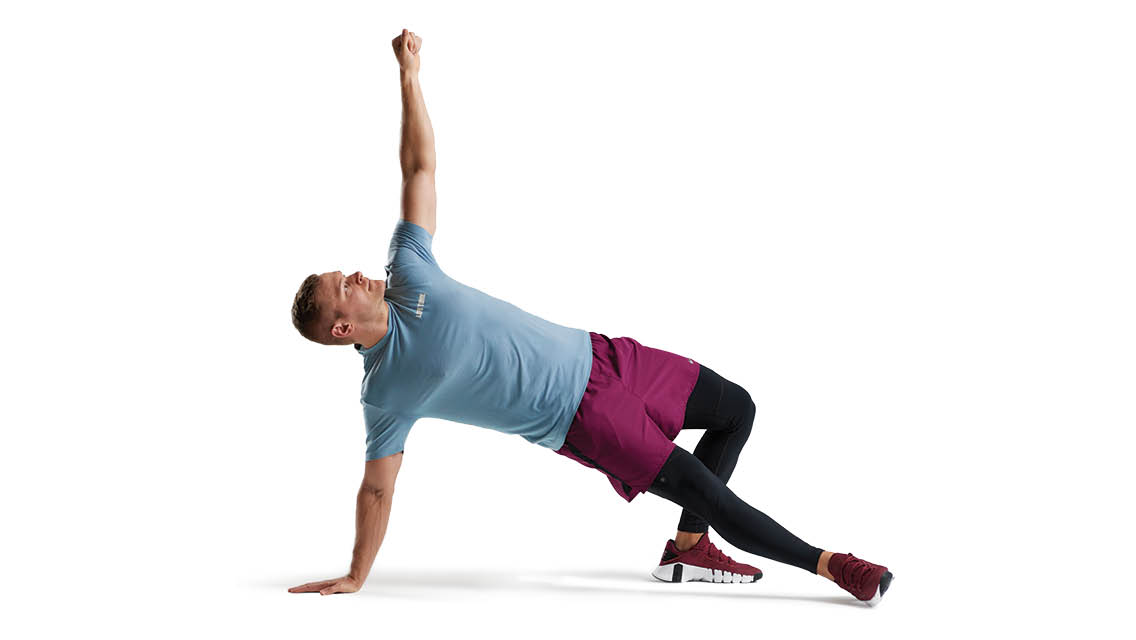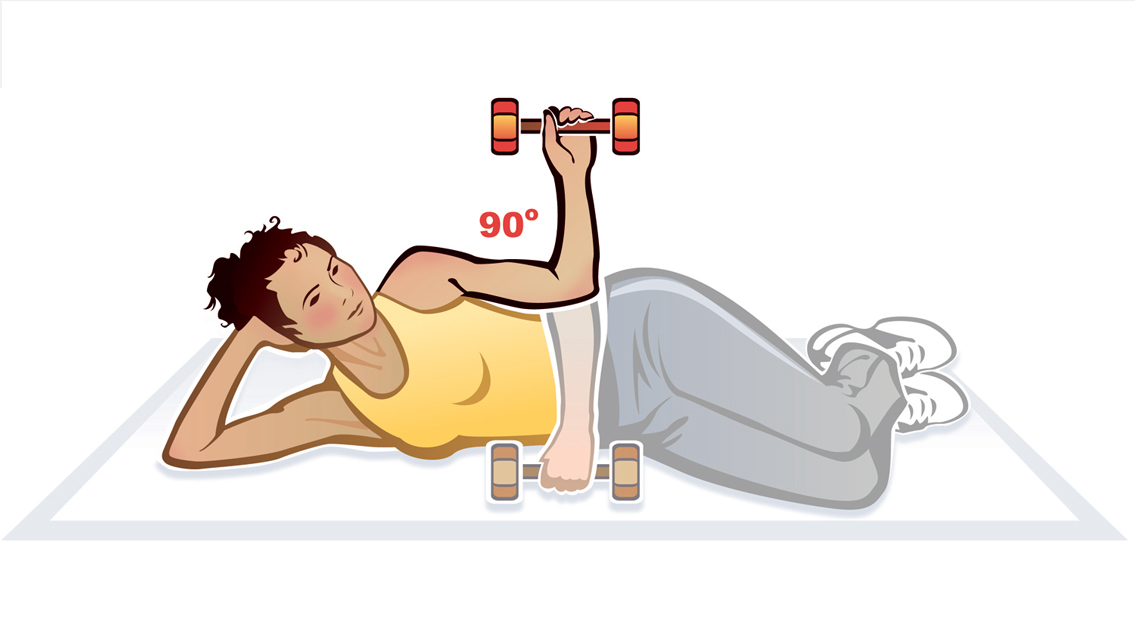Regular movement is key for prehabbing and rehabbing the shoulders. “There’s not much else that really addresses the root cause of the issue and can provide stronger, more injury-resistant shoulders going forward,” says Bowman.
Performing a combination of strength and mobility exercises can help you shore up weak spots in and around the shoulders and teach your shoulders how to move within their full range of motion. This will make everyday tasks easier and even improve athletic performance.
Incorporate the following strength and mobility moves from physical therapist Frikken into your routine up to three times per week. If you already have a strength routine, once per week will be enough, he says.
If shoulder pain prevents you from moving your arm or causes pain at night, seek medical assistance before performing these exercises.
Turkish Get-up
This exercise strengthens the stability of the shoulder in multiple directions.
[/vc_column_text]- Lie on your back with your right leg extended and angled away from your body, right arm out to your side, and left knee bent with left heel on the floor. Make a fist with your left hand and extend it toward the ceiling, keeping your shoulder blade down, or “packed.”
- Drive your left heel into the ground and press your right elbow into the ground as you begin to sit up, leading with your chest. Continue reaching your left arm toward the ceiling.
- Press through your right hand and drive your left heel into the ground to lift your hips off the floor.
- Sweep the right leg back and place your knee on the floor directly under your hip. Keep your chest up, shoulder packed, and spine neutral.
- Rise into a half-kneeling position. Then, pivot your right knee so it faces forward like your left.
- Drive your left heel into the ground to stand.
- Reverse the sequence step by step until you return to the starting position. Complete five sets of one to five repetitions per side.
(Improve your Turkish get-up technique with these three moves.)
Pushup
The pushup is a great all-around exercise for strengthening the shoulders, as well as the triceps, pectorals, and core.
- Set up in a high-plank position, with hands slightly wider than shoulder width, arms extended, and body straight from heels to the top of your head.
- Keeping your body straight and your head in a neutral position, engage your core and squeeze your glutes.
- Bend your arms to lower your chest toward the floor, making sure your elbows flare out no more than 45 degrees.
- Push back to the starting position without breaking the straight line from head to heels.
- Repeat the movement until you feel fatigued, but not burnt out. Do three sets.
- If you’re not ready for the full pushup, do this move on your knees, or elevate your hands on a bench, countertop, or wall.
(Struggle with pain while trying to perform pushups? See “4 Exercises for Pain-Free Pushups“.)
Plank Y-T-I
“This move works the serratus anterior and deltoid muscles on the side holding the plank, as well as the rhomboids and trapezius muscles on the side that’s moving,” Frikken says.
- Set up in a high-plank position, with hands slightly wider than shoulder width, arms extended, and body straight from heels to the top of your head.
- Grip a light dumbbell (start with five pounds or less) in your right hand. Without breaking your high-plank position, extend your arm as though you were forming half of the letter “Y.” Bring your hand back to the floor before extending your arm into half of a letter “T.” Then, “I.” That’s one rep.
- Repeat the movement until you feel fatigued. Do three sets per side.
- Do this movement on your knees if you’re not ready for the high plank version.
Lat Eccentric With PVC
This move helps lengthen the latissimus dorsi muscles in your back. Tightness in these muscles can limit your range of motion in overhead, forward, and extension movements.
- Grab a PVC pipe and thread a five-pound weight plate on it.
- Lie back on a bench and grip the PVC with palms up, elbows straight. Lift both feet so your shins and thighs form 90-degree angles.
- Keeping your elbows straight and your lower back pressed to the bench, slowly lower the PVC pipe behind your head. Work within your current range of motion; you’ve gone too far if the movement feels shaky or uncomfortable.
- Reverse the movement to return to the starting position. Perform 10 reps.
Side-Lying Shoulder External Rotation
The side-lying shoulder external rotation is a staple for strengthening the infraspinatus, a muscle in your rotator cuff that’s key for shoulder stability.
- Lie on your left side and grip a light weight (five pounds or less) in your right hand, with your elbow bent 90 degrees.
- Keeping your right elbow bent, slowly raise your right hand until it points toward the ceiling. Reverse the movement slowly.
- Repeat until you feel fatigued. Do three sets per side.
Foam Roll Rotator Cuff/Latissimus Dorsi
“This is a ‘feel-good’ exercise for the rotator cuff and latissimus dorsi muscles up near our armpit,” Frikken says. The goal is to relax tight muscles that can limit shoulder mobility.
- Lie on your side with a foam roller in your armpit. Roll forward, backward, and side to side until you find a tender spot.
- From there, lift your arm up and down while you make tiny movements around that tender spot with the foam roller.
- Continue for one to two minutes and focus on relaxing that tender area. Switch sides.
This was excerpted from “Exercises for Shoulder Pain: Learn How to Keep Your Shoulders Mobile and Strong” which was published in the December 2022 issue of Experience Life.





This Post Has 0 Comments